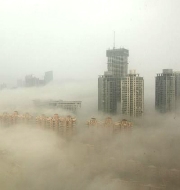Worsening air quality major cause of premature deaths in India: Study
According recent research, worsening air quality in last two decades has emerged as one of major reasons for high numbers of premature deaths in India. The research was conducted by Indian Institute of Technology (IIT)-Delhi in collaboration with environmental NGO Centre for Environment and Energy Development (CEED).
Background
The study was conducted 11 north Indian cities i.e. seven in Uttar Pradesh (Allahabad, Kanpur, Lucknow, Meerut, Varanasi and Gorakhpur), three in Bihar (Patna, Muzaffarpur and Gaya) and one in Jharkhand (Ranchi). It calculated annual mortality burden through averages of recorded deaths caused due to Chronic Obstructive Pulmonary Disease (COPD), Acute Lower Respiratory Infection (ALRI), coronary disease, stroke, and lung cancer in these 11 cities. It also used satellite-based high-resolution PM2.5 database to generate particulate matter statistics for past 17 years.
Key Findings of Research
The annual mortality linked to air pollution was in range of 150-300 persons per 1 lakh population. Kanpur recorded highest number of premature deaths per year (4,173) due to chronic exposure to air pollution, followed by Lucknow (4,127), Agra (2,421), Meerut (2,044), Varanasi (1,581), Allahabad (1,443) and Gorakhpur (914).
COPD was largest cause of deaths (at 29.7%) and lung cancer the lowest (0.6%). The largest share in total burden was attributed to ALRI in Agra and Meerut and to COPD in Allahabad, Gaya, Gorakhpur, Kanpur, Lucknow, Patna, Muzaffarpur and Varanasi.
The estimates were not instant deaths, but represented premature (earlier than expected lifetime of Indian population) deaths due to chronic exposure from pollution. This premature mortality burden will be reduced by 14 to 28% annually if these cities achieve of Indian air quality standards.
The mean annual ambient fine particulate matter (PM) concentration was 75-120% higher than Indian annual air quality standard in 10 of 11 cities. The residential (cooking, heating and lighting) sources are largest contributors to annual ambient PM2.5 concentration (73.8%). Moreover, analysis of aerosol composition indicates higher percentage of sulphates, organic carbons and black carbon emitted primarily from anthropogenic sources.
Month: Current Affairs - May, 2018







